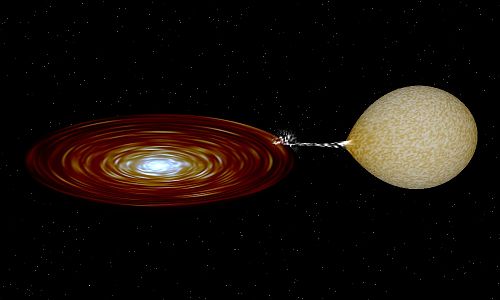ING Joins Efforts with GTC to Discover a Galactic Black Hole
ING web news release
25 April, 2011
XTE J1859+226 is a transient X-ray binary discovered in 1999 by the X-ray
satellite RXTE. X-ray binaries are formed from the pairing of a compact
object, either a neutron star or a black hole, and a 'normal' star. The
compact object pulls out material from the star which eventually falls
onto an accretion disc surrounding the compact object. This type of binary
system stays in quiescence for most of its life; however, from
time-to-time the system can show an outburst at all wavelengths which can
subsequently be detected by X-ray satellites.
 |
Artist impression of XTE J1859+226 system [ JPEG ].
|
Observations of XTE J1859+226 taken in 2000 with the William Herschel
Telescope (WHT) and the Isaac Newton Telescope (INT) exhibited the
sinusoidal modulation of a secondary star. Unfortunately the periodogram
showed a range of possible orbital periods at a 68% confidence level
(Zurita et al., 2002, MNRAS, 334, 999) and more data were necessary to come
to a conclusion about the nature of the object.
New photometry was acquired in 2008 from the Nordic Optical Telescope
(NOT) and again in 2010 using both the NOT and WHT, and spectra were
acquired from the Gran Telescopio Canarias (GTC). Due to the short
integration time of the WHT images the astronomers were able to resolve an
intense flickering which strongly dilutes the secondary star's ellipsoidal
modulation. The object was about one magnitude brighter than in its
quiescence state and showed flares with a time-scale of order 10 minutes
and amplitudes of up to magnitude 0.5.
By combining the data taken using the INT and the WHT in 2000 with the
photometry taken in 2008, an orbital period of 6.6 hours was derived. The
spectra taken with the GTC gave a radial velocity of semi-amplitude 541
km/s. These values give a mass function of 4.5 solar masses which sets a
lower limit to the mass of the compact object, therefore implying the
presence of a black hole. The lack of eclipses and the depth of the minima
in the light curve constrains the inclination of the system to be between
40° and 70°, giving a lower limit to the mass of the black hole of 5.42
solar masses.
There are ~20 dynamically confirmed binaries with black holes out of an
estimated population of a few thousand in our Galaxy.
More information:
- J. M. Corral-Santana, J. Casares, T. Shahbaz, C. Zurita, I. G. Martínez-Pais, P. Rodríguez-Gil, 2011, MNRAS, article first published online: 25 Feb 2011.
- "Descubren un agujero negro de más de cinco veces la masa del Sol", IAC Press Release, 23/03/2011..



